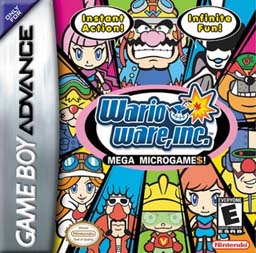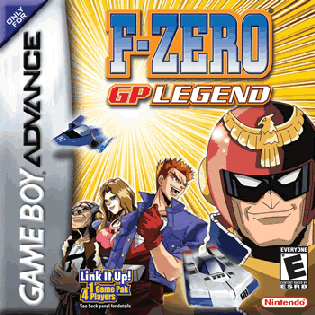
The Game Boy Advance (GBA) is a 32-bit handheld game console developed, manufactured, and marketed by Nintendo as the successor to the Game Boy Color. It was released in Japan on March 21, 2001, in North America on June 11, 2001, in the PAL region on June 22, 2001, and in mainland China as iQue Game Boy Advance on June 8, 2004.

Sonic Advance is a 2001 platform video game developed by Sonic Team and Dimps and published by Sega for the Game Boy Advance. It was the first Sonic the Hedgehog game to be released on a Nintendo console with Sonic Adventure 2: Battle on the GameCube, and was produced in commemoration of the series' tenth anniversary. The story follows Sonic, Tails, Knuckles, and Amy as they journey to stop Doctor Eggman from taking over the world. Controlling a character, players are tasked with completing each level, defeating Eggman and his robot army, and collecting the seven Chaos Emeralds.

WarioWare, Inc.: Mega Microgames!,, known as WarioWare, Inc.: Minigame Mania in the PAL region, is a minigame compilation video game developed and published by Nintendo for the Game Boy Advance. The debut title in the WarioWare series, the game is about rapid completion of "microgames", short minigames given to the player consecutively and with increasing speed per each game complete. The game's concept was inspired by the "Sound Bomber" mode of Mario Artist: Polygon Studio for the Nintendo 64DD. The music and sound effects were recycled from Wario Land 4. The game was produced by Takehiro Izushi and directed by Hirofumi Matsuoka. Matsuoka was also the director of Polygon Studio. Mega Microgames! was released in 2003; in Japan in March, in North America and Europe in May and in Australia in June.

The Pokémon Mini is a handheld game console that was designed and manufactured by Nintendo in conjunction with The Pokémon Company and themed around the Pokémon media franchise. It is the smallest game system with interchangeable cartridges ever produced by Nintendo, weighing just under two and a half ounces. It was first released in North America on November 16, 2001, and was only available for purchase at the Pokémon Center and via its website. This was followed by releases in Japan on December 14, 2001, and in Europe on March 15, 2002. The system was released in three colors: Wooper Blue, Chikorita Green, and Smoochum Purple.

Mega Man & Bass is a 1998 action-platform game developed and published by Capcom. It is a spin-off game in the original Mega Man series and was originally released in Japan for the Super Famicom on April 24, 1998. It was later ported to the Game Boy Advance (GBA) handheld in 2002, and localized in English and released the following year.

Kirby's Adventure is a 1993 action-platform game developed by HAL Laboratory and published by Nintendo for the Nintendo Entertainment System (NES). It is the second game in the Kirby series after Kirby's Dream Land (1992) on the Game Boy and the first to include the Copy Ability, which allows the main character Kirby to gain new powers by eating certain enemies. The game centers around Kirby traveling across Dream Land to repair the Star Rod after King Dedede breaks it apart and gives the pieces to his minions.

Kirby Super Star, released as Kirby's Fun Pak in PAL regions, is an anthology action-platform game developed by HAL Laboratory and published by Nintendo for the Super Nintendo Entertainment System in 1996. It is part of the Kirby series of video games by HAL Laboratory. The game was advertised as a compilation featuring eight games: seven short subsections with the same basic gameplay, and two minigames.

Banjo-Kazooie: Grunty's Revenge is a 2003 platform game developed by Rare for Nintendo's Game Boy Advance (GBA). It is the third instalment in the Banjo-Kazooie series and takes place between the events of the Nintendo 64 (N64) games Banjo-Kazooie (1998) and Banjo-Tooie (2000). In Grunty's Revenge, the evil witch Gruntilda travels back in time to prevent the events of Banjo-Kazooie from happening, and the bear Banjo and his bird friend Kazooie set out to stop her. Grunty's Revenge retains the focus on collecting items and most of the other game mechanics from its predecessors, but is presented in 2D rather than 3D. Aside from the main game, players can also access minigames such as fishing and target shooting.

Castlevania III: Dracula's Curse is a 1989 action-platform game developed and published by Konami for the Nintendo Entertainment System. It was released in Japan in 1989, and in North America in 1990, and in Europe by Palcom in 1992. It was later released on the Virtual Console for the Wii, Nintendo 3DS, and Wii U.

Little Samson is a 1992 action–platform video game developed by Takeru and published by Taito for the Nintendo Entertainment System (NES). The game stars four heroes summoned to stop the demon king Ta-Keed from wreaking havoc on the kingdom of Forgy. Each hero has different abilities and the player can switch between the four at any time.

Densetsu no Stafy 4 is a platform video game developed by Tose and published by Nintendo for the Nintendo DS. It is the fourth game in The Legendary Starfy series. As with the other games in the series, Densetsu no Stafy 4 features Stafy, known as Starfy in Western regions, as the main character. He is joined by his sister Starly and his friend Moe the clam. The three of them help out other undersea creatures and fights numerous villains.

The Legendary Starfy is a video game series developed by Tose and published by Nintendo. The series is the only franchise for which Tose owns the copyright, which they share with Nintendo; as a result, Tose, which normally does not put their company name on their games, does so in the Starfy series. The series began in 2002 with Densetsu no Stafy for the Game Boy Advance, and four sequels were released. For its first seven years, Starfy games were not released outside Japan. The fifth and latest game in the series was released as The Legendary Starfy in North America on June 8, 2009. In July 2024, the first three titles were officially released via the Nintendo Switch Online service.

Tose Co., Ltd. is a Japanese video game development company based in Kyoto. It is mostly known for developing Nintendo's Game & Watch Gallery series, various Dragon Ball games, as well as other Nintendo products. Tose has developed or co-developed over 1,000 games since the company's inception in 1979, but is virtually never credited in the games themselves. Tose maintains a policy of having no creative input into the work they do, going so far as to refuse to put their names in the credits for most of the games they work on. As such, Tose has gained a reputation for being a "ghost developer".

Kirby is an action-platform video game series developed by HAL Laboratory and published by Nintendo. The series centers around the adventures of Kirby as he fights to protect and save his home on the distant Planet Popstar from a variety of threats. The majority of the games in the series are side-scrolling platformers with puzzle-solving and beat 'em up elements. Kirby has the ability to inhale enemies and objects into his mouth, spitting them out as a projectile or eating them. If he inhales certain enemies, he can gain the powers or properties of that enemy manifesting as a new weapon or power-up called a Copy Ability. The series is intended to be easy to pick up and play even for people unfamiliar with action games, while at the same time offering additional challenge and depth for more experienced players to come back to.

Densetsu no Stafy is a platform video game developed by Tose and published by Nintendo for the Game Boy Advance system exclusively in Japan on September 6, 2002. It is the first game in the series The Legendary Starfy. It received its first official re-release on the Nintendo Switch Online + Expansion Pack on July 12, 2024, in all regions for the first time along the other GBA entries.

Densetsu no Stafy 2 is a platform video game developed by Tose and published by Nintendo for the Game Boy Advance in Japan on September 5, 2003. It is the second game in The Legendary Starfy series. It received its first official re-release on the Nintendo Switch Online + Expansion Pack on July 12, 2024, in all regions for the first time along the other GBA entries.

The Legendary Starfy, known as Densetsu no Stafī: Taiketsu! Daīru Kaizokudan in Japan, is a 2008 platform video game developed by Tose and published by Nintendo for the Nintendo DS handheld video game console. It is the fifth game in The Legendary Starfy video game series. On June 8, 2009, the game became the first in the series to be released outside Japan.

Mighty Flip Champs! is a puzzle-platform game developed and published by WayForward Technologies for the Nintendo DSi's DSiWare digital download service. It was released on June 1, 2009, in North America and on November 27 in the PAL regions. The developers took inspiration from multiple sources, including the video games Wendy: Every Witch Way and The Legend of Zelda: A Link to the Past. In it, players control Alta, a girl who has to reach a fishman by flipping between areas until she can reach him. Since its release, Mighty Flip Champs! received all-around positive reception, while also being called one of the best video games for the DSiWare service. It is the first game in the Mighty series, and is followed by Mighty Milky Way, Mighty Switch Force! and Mighty Switch Force! 2.

F-Zero: GP Legend is a futuristic racing video game for the Game Boy Advance handheld. Developed by Suzak Inc., it was released in Japan in 2003 and in Europe and North America in 2004.




















